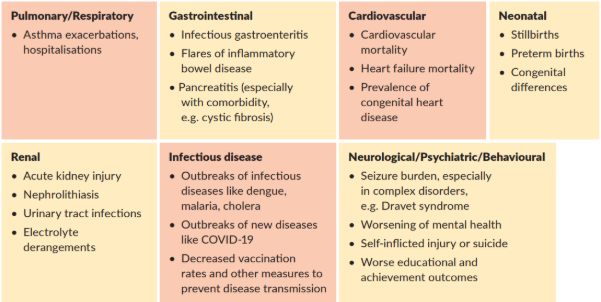"Britain Braces for Its First Heat Wave of the Year" ran the headline in the New York Times last month, reporting predicted temperatures in the UK of 34°C.
It’s right that the UK’s heatwave was recognised as a serious news event, both here and internationally. It carried serious health risks, with an estimated 600 heat-related deaths expected last month.
At the same time, it’s important to recognise that heatwaves here in the UK don’t occur in isolation. They reflect changes across our rapidly warming world. And heatwaves disproportionately impact children, particularly their health. This latest UK heatwave reminds us that we need urgent and bold action to protect the most vulnerable populations from the impacts of climate change.
2024: the world’s hottest year on record
Heatwaves are happening more often, more intensely and for longer in many parts of the world, posing a massive threat to people’s lives. Heat, particularly in humid conditions, is extremely dangerous to human health.
The indicators are ominous. All in all, 2024 was the world’s hottest year on record.
Last year, large regions of South Asia and the Middle East experienced temperatures well above 40°C for days on end, causing hundreds of deaths. It’s important to bear in mind that heat-related mortality is often difficult to calculate in these areas and may therefore be under-reported.
The affected areas include fragile and emergency contexts where populations live in refugee camps or informal housing and are particularly vulnerable to the heat. And where health systems are already disrupted or overwhelmed. Agriculture is also hit by drought and high temperatures, causing or exacerbating widespread food insecurity.
In Gaza last year, 1.7 million displaced people were subject to these high temperatures, on top of unrelenting bombardment by Israeli forces and enforced water shortages.
3.6 billion people
Experts are clear: human-induced climate change has increased the frequency, severity and duration of these events. While heat-related mortality is often under-reported, the World Health Organization has estimated that 3.6 billion people are currently extremely susceptible to the impact of climate change and predicts 250,000 people will die as a result each year. In Europe and Central Asia alone, close to 400 children are killed by heat annually.
While climate change affects us all, the brunt of its human cost is borne by the world’s poorest and most vulnerable communities, including children, women, those with chronic illness and displaced people. In other words, the people who have done the least to cause this crisis.
How does climate change affect global health?
While direct heat leads to conditions like heatstroke, what makes heatwaves far more deadly are increases in malnutrition, infections, and respiratory and other non-communicable diseases. Higher temperatures and humidity levels allow mosquitos and other disease vectors to proliferate. We are already seeing the emergence/re-emergence of mosquito-borne diseases such as dengue fever in places with previously low or no incidence. A more than 80% rise in people at risk of malaria in Africa is predicted over the next 10 years.
Four years ago, I was working at a children’s hospital in northern Laos when the pre-monsoon ‘hot season’ reached temperatures deemed unnatural by local staff. For the first time, we saw children on conventional maintenance fluid regimes becoming dehydrated. Climate change also impacts mental and psychosocial health and well-being, both acutely and in the long-term.
The chart below summarises the impacts of heat on children’s health:
How extreme heat affects children’s health

Source: Extreme Heat and Children's Development and Wellbeing, Shruti Agarwal, Save the Children UK, 2024
The huge rise in healthcare needs induced by high temperatures is likely to overwhelm already under-resourced and fragile health systems, particularly in countries on the frontline of the climate emergency. Health systems strengthening needs significant investment now to meet current demands and ensure resilient health services that can respond to climate-induced emergencies in low-resource settings.
The global challenge
Limiting global heating to 1.5°C above pre-industrial levels is required to maintain a habitable planet and prevent the worst climate change impacts. However, under current climate commitments – which leave the world on course for 2.7°C above pre-industrial levels by the end of the century and likely to exceed 1.5°C between the early 2030s and 2040s – about 100 million of the estimated 120 million children born in 2020 will face unprecedented lifetime exposure to extreme heat. When the global mean temperature reaches 1.5°C above pre-industrial levels, the increase in mean and extreme temperatures in the hottest countries will be much higher than that.
The challenge for the UK
Yet at this crucial moment, the political climate could not be less favourable. While the UK Labour Party has declared its desire to be a “clean energy superpower” by 2030, the reversion to austerity politics as the cost-of-living crisis continues and polarisation of the climate debate in Westminster, threaten the government’s ability to deliver on its green aims.
Added to this, the UK’s decision to cut overseas aid to 0.3% of national income, coupled with the devastating impact of other donor cuts, will severely limit the abilities of the most climate-vulnerable countries to strengthen their health systems and adapt to the changing climate.
The UK government must go further, faster
The UK government must go further and faster to protect children from the devastating impacts of heatwaves and other climate extremes, both at home and overseas.
Making the biggest and richest polluters in the UK pay has the potential to generate much needed funding to boost support for domestic and international climate action.





